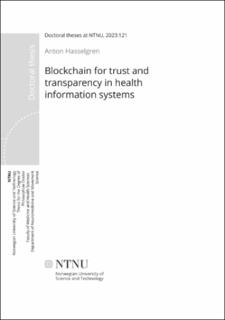| dc.contributor.advisor | Faxvaag, Arild | |
| dc.contributor.advisor | Kralevska, Katina | |
| dc.contributor.advisor | Gligoroski, Danilo | |
| dc.contributor.author | Hasselgren, Anton | |
| dc.date.accessioned | 2023-04-21T09:20:04Z | |
| dc.date.available | 2023-04-21T09:20:04Z | |
| dc.date.issued | 2023 | |
| dc.identifier.isbn | 978-82-326-6150-3 | |
| dc.identifier.issn | 2703-8084 | |
| dc.identifier.uri | https://hdl.handle.net/11250/3064202 | |
| dc.description.abstract | Background
The research presented in this thesis explores whether the emerging technology of blockchain can provide value in the health domain. The research project is, in essence, interdisciplinary, migrating across health science, health informatics, computer science to cryptography. Challenges around trust, access control, data transparency and data provenance are present in health information systems and e-health applications. The emerging blockchain technology encapsulates inherited characteristics that provide data transparency, tamper-proof, integrity, and provenance. Exploring whether blockchain technology can provide any value to these challenges and the health system as a whole, is therefore of interest.
The research project aimed to explore the topic of blockchain applications in health information systems. The aim extended to the design and development of an e-health related service that utilizes blockchain properties and evaluates that service.
Methods
This research work has adopted a problem-driven approach and is based on design science and user-centered design theory. Three studies were undertaken in the scope of the research: a systematic literature review, a proof-of-concept study and a feasibility study.
Results
Systematic literature review: 39 publications were included in the review after screening based on strict inclusion criteria. The result indicates that Electronic Health Records and Personal Health Records are the areas most targeted by blockchain technology. Access control, interoperability, provenance and data integrity are all issues blockchain technology should be able to improve in this field. Ethereum and Hyperledger fabric seem to be the most used platforms/frameworks in this domain.
Proof-of-concept: This study determined and defined the crucial functional and non-functional requirements and principles for enhancing trust between caregivers and patients within a virtualized health care environment. The cornerstone of the architecture was a blockchain technology utilization approach. The proposed decentralized system provides an innovative governance structure for a novel trust model, and the presented theoretical design principles are supported by a concrete implementation of an Ethereum-based platform named VerifyMed.
Feasibility study: Five themes were identified from the interviews and focus groups held with real users of the system, after they were exposed to a mock-up of VerifyMed: (1) the need for aggregated storage of work and study-related verification, (2) trust in a virtual health care environment, (3) the potential use of patient feedback, (4) trust in blockchain technology, and (5) improvements of the VerifyMed concept. The System Usability Score questionnaire gave a score of 69.7.
Discussion
It is essential to systematically explore the digital transformation that is stimulated by new technologies, and their potential impact on health systems. Following a development cycle founded in design science, increases the development of a high-quality and fit-for-purpose system. The results from the feasibility study indicate that VerifyMed has a high degree of fit-for-purpose. System users expressed that a decentralized system for the storage of work-related verifiable credentials could increase trust in the health system, particularly where there are fewer trusted institutions as a result of an increase in the number of health care providers in a digitally transformed healthcare system. An advantage of this research project is the interdisciplinary approach to the multi-leveled topic of blockchain in health information systems. The VerifyMed project should advance to the next steps in the development cycle applied to this project, these being the development of an updated prototype based on the feasibility study’s input and testing the effect with real users. It is likely, where health services are provided in a virtual environment, that blockchain will provide value in digital transformed health systems. A decentralized technology that can guarantee data provenance and integrity could provide significant value to the maintenance of trust in a future in which physical interaction decrease. | en_US |
| dc.language.iso | eng | en_US |
| dc.publisher | NTNU | en_US |
| dc.relation.ispartofseries | Doctoral theses at NTNU;2023:121 | |
| dc.relation.haspart | Paper A: Hasselgren, Anton; Kralevska, Katina; Gligoroski, Danilo; Pedersen, Sindre Andre; Faxvaag, Arild. Blockchain in healthcare and health sciences—A scoping review. International Journal of Medical Informatics 2019 ;Volum 134:104040. s. 1-10 This is an open access article under the CC BY-NC-ND license | en_US |
| dc.relation.haspart | Paper B: Hasselgren, Anton; Rensaa, Jens-Andreas Hanssen; Kralevska, Katina; Gligoroski, Danilo; Faxvaag, Arild. Blockchain for increased trust in virtual health care: Proof-of-concept study. Journal of Medical Internet Research 2021 ;Volum 23.(7) s. 1-15 https://doi.org/10.2196/28496 This is an open-access article distributed under the terms of the Creative Commons Attribution License (CC BY 4.0) (https://creativecommons.org/licenses/by/4.0/) | en_US |
| dc.relation.haspart | Paper C: Hasselgren, Anton; Kralevska, Katina; Gligoroski, Danilo; Faxvaag, Arild. Medical students' perceptions of a blockchain-based decentralized work history and credentials portfolio: Qualitative feasibility study. JMIR Formative Research 2021 ;Volum 5.(10) s. 1-10 https://doi.org/10.2196/33113
This is an open-access article distributed under the terms of the Creative Commons Attribution License (CC BY 4.0) (https://creativecommons.org/licenses/by/4.0/) | en_US |
| dc.title | Blockchain for trust and transparency in health information systems | en_US |
| dc.type | Doctoral thesis | en_US |
